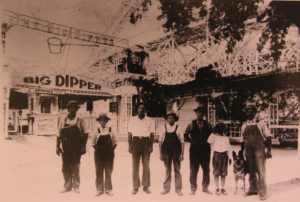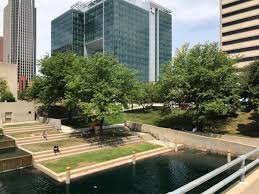Erastus Benson was born in Iowa in 1864, the same year as Omaha City. He came to Omaha as a young man and would play a very important role in the city’s early development. Over the course of his life, he practiced law, taught school, wrote poetry, edited a newspaper, was an important investor in Thomas Edison’s early inventions, and was one of the largest real estate developers in early Omaha. In addition to his property in Benson, it has been estimated that about 5% of Omahans lived on property Benson developed.[1] In one [unspecified] year, he was said to have paid taxes on more than 1,000 properties.[2]
In 1887, very shortly after arriving in Omaha, Benson purchased 900 acres of land to the northwest of the city. This first land purchase, which he named Benson Place, was obtained from John Creighton (one of the founders of the university), and was sparsely-developed farmland where wild strawberries thrived.[3] From the beginning, he planned to develop this parcel into a village. At the same time that he bought the lane, he applied for a permit to run a streetcar line from Omaha to connect the two towns. Benson Place was platted by March 4, 1887. In the spring of that year, the Benson and Halcyon Heights street railway line opened and ran until it, too, was annexed by the Omaha and Council Bluffs Street Railway Company.

An early Benson home located northwest of 66th & Wirt, ca. 1900. Photo courtesy of the Douglas County Historical Society.
Like some of the other small towns established near Omaha, growth was slow at first. In order to draw prospective buyers out to the new town (about nine miles from downtown Omaha), Benson arranged for a herd of buffalo to be brought out to graze along present-day Maple Street. They were looked after by a man known as “Buffalo Jones”. When curious Omahans would come out to have a look at some real-life buffaloes, Mr. Benson would also draw their attention to the fledgling development nearby.[4] The first ten years brought only about 200 new inhabitants, but there was an influx in development once Benson incorporated as a village in 1897. By 1907, the population had reached 1,600 – in 1912, over 4,000 called Benson home.
A humanitarian in addition to his other pursuits, Erastus Benson believed that home ownership was an important part of building successful new communities. When new residents fell on hard times, Mr. Benson was known to forgive overdue payments and often refused to accept accrued interest.[5] The land for Benson’s first school (Seeley School), town hall, and the St. James orphanage were all donated to the town by Mr. Benson.
By the early 1900s, Benson was a full-blown town, with several schools and churches, a volunteer fire department, paved streets, electricity, and its own newspaper. If there was anything its inhabitants lacked, downtown Omaha was still just a streetcar ride away.

The Benson Times building that was located between 62nd and 63rd on the south side of Maple from 1903-1908. Lou Raber was the publisher of the newspaper and a subscription was $1.00 per year. Photo courtesy of the Douglas County Historical Society.
In 1895, Benson also became home to a top-notch amusement park featuring a tunnel of love, roller coaster, hot air balloons, live performances, and more. In 1902, the park was purchased by the Frederick Krug Brewing Company and became known as Krug Park. It would be a hub of activity until its closure in 1940. The land is now home to Gallagher Park at 52nd and NW Radial Highway.

Krug Park employees standing at the base of “The Big Dipper” roller coaster. In 1930, this coaster would be the scene of the United States’ deadliest roller coaster accident to date. No date. Photo courtesy of the Douglas County Historical Society.
In 1917, at the same time that Omaha received permission from the Governor to annex Florence without a vote, they also had their eye on the prosperous suburb of Benson. Benson’s mayor, F.A. Bailey, was opposed, on the grounds that Benson’s situation was so different from that of Florence. There was a small stretch of undeveloped and unplatted land between the towns, which the town of Benson used to claim that they were separate from Omaha and not infringing upon their development. Omaha, however, asserted that the strip was small enough that Benson was essentially bordering on Omaha. Despite their disapproval, the residents of Benson foresaw that annexation was imminent, and they suspected that once they were part of the larger city, their neighborhood needs might go unanswered. So, in 1915, the town decided to refinish streets, build a brand-new combined fire station and city hall, and install new streetlights. In 1917, Omaha acquired the debt for these projects along with the rest of Benson.
[1] “No Doubt About It, Erastus Benson Had a Flair.” Omaha World-Herald, 1977.
[2] “E.A. Benson, 77, Succumbs to Long Illness.” Omaha Daily Bee, 1932.
[3] “Erastus Benson Buffaloed Buyers.” News article, paper unknown.
[4] Ibid.
[5] “E.A. Benson, 77, Succumbs to Long Illness.” Omaha Daily Bee, 1932.
